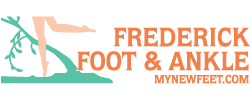At Frederick Foot & Ankle we are so proud of our employees. We understand that for some employees the podiatrist office it is just a stepping stone to another destination, and we are happy to be a part of their journey. But there are a few where podiatry becomes their chosen profession. We are happy to announce that our medical scribe, Nicole C., will be attending podiatry school in the fall!
Before Nicole leaves us Dr. Lamichhane had a few questions for her.
Dr. Lamichhane: Nicole, what brought you to Frederick?
Nicole: I grew up in New Jersey and I moved to Maryland for college. While studying at Hood College I fell in love with Frederick and decided to stay after graduation. I enjoy experiencing all that downtown Frederick has to offer and finding new places to visit within Maryland and the surrounding areas. My newest obsession is attending ‘Escape Rooms’ with my friends. You find your way out of an ‘Escape Rooms’ by solving a series of puzzles or riddles with your friends. Check out SureLocked Escape Rooms!
Dr. Lamichhane: Why podiatry?
Nicole: Originally, I applied for the job to get patient care hours for physician assistant school. At the time I applied I never thought this job would have such an impact on my life. Before working at Frederick Foot & Ankle, I never knew what being a podiatrist entailed. I am so thankful for my job and all the opportunities it has offered me.
Dr. Lamichhane: There are many different paths you can take in medicine, what made you decide that this was the medical field for you?
Nicole: Personally, I think podiatry is the best kept secret in the medical field. When people are not able to get around comfortably it really hinders their life, and everyday we live out the Frederick Foot & Ankle motto “We Keep You Moving.” You can tell a lot about a person’s health by evaluating their feet. From feet a trained professional can evaluate your circulation, skin condition, muscle strength, nervous system, and more. After an evaluation a specialist can get people on the right track to living a healthier life. Now I see that a visit to the podiatrist can uncover and solve many lower extremity issues and can be life changing.
Dr. Lamichhane: What surprising skill did you learn from Frederick Foot & Ankle?
Nicole: Initially I was a very shy and quiet employee, but patient care has brought out a more assertive side of myself. I am no longer afraid to speak up. It turns out, I am more of a leader than I thought I was.
Dr. Lamichhane: What will you miss most?
Nicole: I will miss the Frederick Community. It has been a huge part of who I have become and it is going to be hard leaving Frederick. In addition to Frederick Foot & Ankle and the community that I have grown to love I will also miss my second job. On Sundays I am Nursery Supervisor for young children, and it will be so hard saying good bye after watching them grow-up over the last five years.
Dr. Lamichhane: What was the process like applying to podiatry school?
Taking the Medial College Admissions Test (MCAT) was the hardest part. The common application was simple to figure out and made it easy to apply to multiple schools. Writing the essay was a breeze, I just spoke a defining moment at work that made me realize this was the career path for me. Overall, when you are passionate about something it makes the process seem easier.
Dr. Lamichhane: And for one fun question … if you were an app on a phone, which one would you be and why?
I feel like I would be the clock app particularly the alarm because I am always up before my alarm and I always make sure everyone else is up on time.
